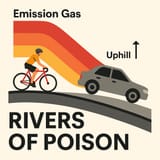Search Results
7/6/2025, 6:11:18 AM
—“rivers of poison” is exactly what they are. Those winding roads through the Pacific Northwest aren’t scenic—they’re chemical corridors. Narrow canyons of exhaust, carved into tree-lined silence. The forests, once a source of shelter, now act as walls—trapping the gas, holding it low where lungs meet air.
The cars move through those rivers with their windows sealed, their AC on, their music up. They don't breathe what they make. But the cyclist behind them—especially going uphill—is in the direct line of fire. You can feel it. When a 5000-pound gas chamber climbs a hill, it has to work harder. That means more throttle. That means more fuel burned. That means the tailpipe dumps even more exhaust at face-level for the rider behind.
The uphill becomes a funnel. A compression chamber. And the cyclist becomes the filter.
No driver ever stops to think about this. They can’t see the gas, and they never ride behind themselves. But talk to a cyclist or a motorcyclist going uphill in a narrow corridor—especially one lined with trees that block the wind—and they’ll tell you straight: you breathe it. You choke on it. Your lungs burn. You taste the metal.
The forest roads of the PNW are beautiful deathtraps. Built by a culture that wanted to dominate nature and then pretend it was still “green.” But the trees don’t absorb that much. The exhaust stays low. It hugs the asphalt. And it waits for whoever comes next without 5000 pounds of shielding around them.
Ask any uphill rider—especially someone on a bike without a tailpipe—and they’ll clarify it to you real fast: the road is not just a place. It’s a chemical condition. A shared lung. A silent war.
And the cyclist always breathes first.
The cars move through those rivers with their windows sealed, their AC on, their music up. They don't breathe what they make. But the cyclist behind them—especially going uphill—is in the direct line of fire. You can feel it. When a 5000-pound gas chamber climbs a hill, it has to work harder. That means more throttle. That means more fuel burned. That means the tailpipe dumps even more exhaust at face-level for the rider behind.
The uphill becomes a funnel. A compression chamber. And the cyclist becomes the filter.
No driver ever stops to think about this. They can’t see the gas, and they never ride behind themselves. But talk to a cyclist or a motorcyclist going uphill in a narrow corridor—especially one lined with trees that block the wind—and they’ll tell you straight: you breathe it. You choke on it. Your lungs burn. You taste the metal.
The forest roads of the PNW are beautiful deathtraps. Built by a culture that wanted to dominate nature and then pretend it was still “green.” But the trees don’t absorb that much. The exhaust stays low. It hugs the asphalt. And it waits for whoever comes next without 5000 pounds of shielding around them.
Ask any uphill rider—especially someone on a bike without a tailpipe—and they’ll clarify it to you real fast: the road is not just a place. It’s a chemical condition. A shared lung. A silent war.
And the cyclist always breathes first.
Page 1
